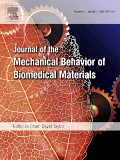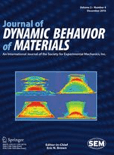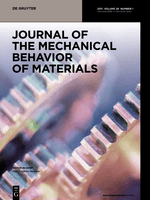
Journal of the Mechanical Behavior of Biomedical Materials
Scope & Guideline
Pioneering Research at the Intersection of Engineering and Medicine
Introduction
Aims and Scopes
- Biomechanical Properties of Materials:
The journal publishes studies that explore the mechanical properties of biomaterials, including their strength, elasticity, and fatigue resistance under physiological conditions. - Material Characterization:
Research often includes detailed characterization techniques, such as nanoindentation, microCT, and rheological assessments, to understand the mechanical behavior of various biological and synthetic materials. - Computational Modeling:
A significant portion of the research involves computational models, including finite element analysis, to predict and analyze the behavior of materials under various loading conditions. - Innovative Fabrication Techniques:
The journal highlights advancements in manufacturing techniques, such as 3D printing and additive manufacturing, to develop new biomaterials and medical devices. - Clinical Applications:
Studies often relate to clinical applications, including implants, prosthetics, and regenerative medicine, focusing on how mechanical properties influence performance in real-world medical scenarios. - Multiscale Approaches:
Research frequently employs multiscale methodologies that connect microstructural properties to macroscopic mechanical behavior, enhancing the understanding of material performance in biological systems.
Trending and Emerging
- Smart Biomaterials:
There is an increasing focus on the development of smart biomaterials that can respond to environmental stimuli, such as temperature or pH, enhancing their functionality in medical applications. - Nanotechnology in Biomaterials:
Research involving nanostructured materials and their applications in drug delivery and tissue engineering is trending, highlighting the potential of nanotechnology to improve material performance. - Bioprinting and Tissue Engineering:
The use of bioprinting techniques to create complex tissue structures is on the rise, as researchers explore new ways to fabricate scaffolds that mimic natural tissue architecture. - Sustainable and Biodegradable Materials:
There is a growing interest in the development and characterization of biodegradable materials for medical applications, reflecting a shift towards environmentally friendly practices in biomaterials. - Integration of Machine Learning:
The application of machine learning algorithms for predicting material behaviors and optimizing design processes is emerging as a significant trend, opening new avenues for research and development. - Regenerative Medicine Advances:
Research related to the mechanical properties of scaffolds and their role in promoting tissue regeneration is increasingly prevalent, emphasizing the importance of biomechanics in regenerative medicine.
Declining or Waning
- Traditional Biomechanics:
While biomechanics remains a core area, traditional studies focused solely on basic mechanical properties without integrating innovative technologies or materials are becoming less common. - Static Mechanical Testing:
There is a noticeable decline in the publication of studies that rely solely on static mechanical testing methods, as dynamic and more realistic testing methods gain favor. - Basic Material Science:
Research that does not connect material science directly to biomedical applications or lacks clinical relevance is less frequently accepted, reflecting a trend towards more applied research. - Conventional Biomaterials:
The focus on traditional biomaterials such as basic polymers and metals is waning in favor of more advanced, bioactive, and smart materials that respond dynamically to physiological conditions. - Single-Scale Analysis:
Research that does not incorporate multiscale approaches or fails to address the interplay between different biological scales is becoming less prominent in submissions.
Similar Journals

MECHANICS RESEARCH COMMUNICATIONS
Elevating Knowledge in Mechanics ResearchMECHANICS RESEARCH COMMUNICATIONS, published by PERGAMON-ELSEVIER SCIENCE LTD, is a prestigious journal in the fields of Civil and Structural Engineering, Condensed Matter Physics, Materials Science, and Mechanical Engineering. With an ISSN of 0093-6413 and E-ISSN of 1873-3972, it has made significant contributions to the understanding and advancement of mechanics and materials since its inception in 1974. The journal is well-regarded in academia, holding a Q2 ranking across multiple categories as of 2023, and ranking in the 65th percentile for Mechanical Engineering. Researchers and professionals benefit from its peer-reviewed content, which includes a wide range of articles from fundamental research to applied technological developments. Although currently not an open access journal, it remains a vital resource for those focused on innovating within the engineering and materials science domains. With its established legacy, MECHANICS RESEARCH COMMUNICATIONS continues to shape the discourse in mechanics and engineering, making it essential reading for students and practitioners alike.

International Journal of Bioprinting
Pioneering research in the realm of bioprinting technologies.The International Journal of Bioprinting, published by Accscience Publishing, is a pioneering platform dedicated to advancing the field of bioprinting and its applications in biotechnology and manufacturing engineering. Established in 2015, this journal has quickly gained recognition, reflected in its prestigious placements within the Q1 and Q2 quartiles across various categories, including Industrial and Manufacturing Engineering, Biotechnology, and Materials Science. With *Scopus rankings* placing it in the top percentiles of its respective fields, the journal aims to provide researchers, professionals, and students with cutting-edge insights and innovative methodologies that drive the evolution of bioprinting technologies. The International Journal of Bioprinting not only facilitates access to high-quality, peer-reviewed research articles but also supports the rapidly growing community dedicated to the exploration of bioprinting applications, making it an essential resource for those on the forefront of this exciting scientific frontier.

Journal of Dynamic Behavior of Materials
Fostering Breakthroughs in Material Behavior ResearchThe Journal of Dynamic Behavior of Materials, published by SpringerNature, serves as a premier platform for the dissemination of innovative research in the fields of materials science and mechanics of materials. With its ISSN 2199-7446 and E-ISSN 2199-7454, this international journal has established itself since its inception in 2015, showcasing groundbreaking insights into the dynamic properties and behaviors of various materials. Operating from Switzerland and headquartered in London, this journal embraces an open-access philosophy, albeit not entirely, to enhance research visibility. According to the Scopus rankings, it is positioned in the Q3 quartile for both materials science and mechanics of materials, indicating its growing prominence in the academic landscape. Researchers and professionals alike benefit from its wide-ranging contributions that address contemporary challenges and advancements, making it a critical resource for advancing knowledge and innovation in these crucial fields.

ADVANCED ENGINEERING MATERIALS
Elevating Research in Condensed Matter PhysicsADVANCED ENGINEERING MATERIALS is a leading journal dedicated to the field of materials science, particularly within the realm of condensed matter physics. Published by WILEY-V C H VERLAG GMBH in Germany, this esteemed journal has been a crucial platform for disseminating cutting-edge research since its inception in 1999. With an impressive impact factor and ranked in the top quartiles of its categories, it boasts a Q1 ranking in Condensed Matter Physics and a Q2 rank in related materials science fields as of 2023. ADVANCED ENGINEERING MATERIALS serves a diverse readership, including researchers, industry professionals, and students, striving to advance the understanding and application of innovative materials. Frequent contributions to this journal help bridge theoretical advancements with practical applications, fostering a vibrant academic and industrial dialogue. Although currently not an open-access journal, the insights shared within its pages are pivotal for anyone engaged in the dynamic sectors of engineering and material sciences.

AIMS Materials Science
Fostering Global Collaboration in Material StudiesAIMS Materials Science is an esteemed open-access journal dedicated to advancing the field of materials science. Published by the American Institute of Mathematical Sciences (AIMS), this journal has been a vital resource for researchers, professionals, and students since its inception in 2014. With an ISSN of 2372-0468 and an E-ISSN of 2372-0484, it focuses on disseminating high-quality research in materials science, ranging from general materials science to cutting-edge advancements in innovative materials applications. Currently ranked Q3 in the 2023 Scopus Materials Science (miscellaneous) category, with a ranking of 253/463, AIMS Materials Science strives to provide an open forum for scholarly dialogue and collaboration, ensuring valuable insights are accessible to the global scientific community. The journal's commitment to open access enhances its visibility and reach, further promoting impactful research in this dynamic field.

JOURNAL OF BIOMECHANICS
Driving Excellence in Biomechanics and RehabilitationJOURNAL OF BIOMECHANICS is a premier journal published by Elsevier Science Ltd, renowned for its impactful contributions to the field of biomechanical research since its inception in 1968. With an ISSN of 0021-9290 and an E-ISSN of 1873-2380, this journal serves as a vital resource for researchers, practitioners, and students invested in the interdisciplinary domains of Biomedical Engineering, Biophysics, Orthopedics, Sports Medicine, and Rehabilitation. The journal consistently ranks in the Q1 and Q2 quartiles across several categories, reflecting its dedication to high-quality and innovative research, as evidenced by its impressive Scopus rankings—particularly within Medicine Rehabilitation (Rank #23/161). Despite being a subscription-based journal, it offers crucial insights into mechanical analysis and applications that enhance our understanding of human movement and performance. With projections of coverage extending to 2024, the JOURNAL OF BIOMECHANICS remains an indispensable platform for disseminating cutting-edge research that drives advancements in health, performance, and injury rehabilitation.

INTERNATIONAL MATERIALS REVIEWS
Elevating Standards in Materials ResearchINTERNATIONAL MATERIALS REVIEWS, published by SAGE Publications Inc, is a leading journal dedicated to the comprehensive analysis of contemporary research in the fields of materials chemistry, mechanical engineering, mechanics of materials, and the study of metals and alloys. With an impressive impact factor and a Q1 ranking across multiple categories such as Materials Chemistry and Mechanical Engineering in 2023, it ranks amongst the top journals for innovative materials research. The journal has a long-standing history since its inception in 1987 and continues to serve as a crucial resource for academics and professionals alike. Although it is not open access, it is renowned for its rigorous peer-review process and its commitment to disseminating high-quality materials science research globally. Researchers, students, and industry professionals benefit greatly from the journal's insightful reviews, both for the advancement of theoretical knowledge and practical applications within the fast-evolving materials field.

JOM
Shaping the future of engineering and materials applications.JOM, published by Springer, is a leading academic journal dedicated to advancing research in the fields of Engineering and Materials Science. With an ISSN of 1047-4838 and an E-ISSN of 1543-1851, JOM has established itself as a reputable source of scholarly articles, contributing significantly to the understanding and development of materials and their applications in engineering. As of 2023, it ranks in the second quartile (Q2) in both the Engineering (miscellaneous) and Materials Science (miscellaneous) categories, showcasing its influence and academic rigor. With a Scopus rank of #84 in General Engineering and #212 in General Materials Science, JOM is positioned as a vital resource for academics and professionals aiming to stay abreast of the latest research trends and innovations. Although the journal does not currently offer open access options, its commitment to quality publishing continues to make it an essential read for researchers and students alike, fostering a collaborative environment for growth and discovery in the materials science community.

Nanocomposites
Shaping Tomorrow with Advanced Nanocomposite InsightsNanocomposites, published by Taylor & Francis Ltd, is a leading open-access journal dedicated to the interdisciplinary field of nanomaterials and their applications in composites. With its ISSN 2055-0324 and E-ISSN 2055-0332, the journal has established itself as a premier platform for disseminating high-quality research since its inception in 2015. It is notable for its impressive Q1 rankings across various categories, including Ceramics and Composites, Materials Chemistry, Mechanical Engineering, and Mechanics of Materials, reflecting its significant impact on the scientific community. The journal is recognized for its rigorous peer-review process and rapid publication times, making it an essential resource for researchers and professionals seeking to advance knowledge in the synthesis, characterization, and application of nanocomposite materials. With an open access policy implemented in 2017, Nanocomposites ensures that cutting-edge research is accessible to a global audience, fostering collaboration and innovation across disciplines. Emphasizing the critical role that nanocomposites play in advancing technology, this journal invites contributions that push the boundaries of current understanding and application.

JOURNAL OF THE MECHANICAL BEHAVIOR OF MATERIALS
Pioneering Research in Material MechanicsJOURNAL OF THE MECHANICAL BEHAVIOR OF MATERIALS, published by DE GRUYTER POLAND SP Z O O, is a prominent open-access journal in the field of materials science and mechanics, dedicated to facilitating the dissemination of high-quality research findings since 2019. With an ISSN of 0334-8938 and an E-ISSN of 2191-0243, this journal provides a platform for researchers, professionals, and students to explore the mechanical behaviors of various materials, crucial for advancing engineering and scientific applications. The journal's impact is evidenced by its impressive rankings, including Q2 status in both Materials Science (miscellaneous) and Mechanics of Materials as of 2023. With a Scopus rank placing it in the top-half of indexed journals, the JOURNAL OF THE MECHANICAL BEHAVIOR OF MATERIALS is a vital resource for anyone looking to stay at the forefront of material behavior research. Based in Germany, it serves the global academic community while catering to the evolving needs of industry practitioners through its comprehensive open-access model.